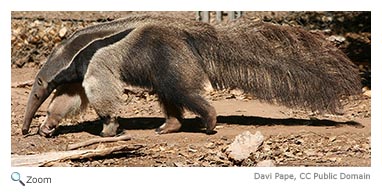Myrmecophagidae -
Anteaters |
|
|
 There are three species in this family. They are found in the grasslands and rainforests of Central and South America. There are three species in this family. They are found in the grasslands and rainforests of Central and South America.
Anteaters have very long, tubular snouts and long, thin, sticky tongues! They have small ears; small eyes; small mouths; no teeth; and five long, strong, curving claws on their front feet. Their claws don't retract, so anteaters walk on their knuckles! Anteaters have long tails and in some species, the tail is prehensile.
Anteaters use their long, sticky tongues to gather up the ants, termites, and other insects. Anteaters are solitary. Females give birth to a single baby and carry it around on their backs! The giant anteater lives on the ground, and the
northern tamandua and the southern
tamandua spend time in trees and on the ground!
World Status Key
 Least Concern Least Concern  Near Threatened Near Threatened  Vulnerable Vulnerable  Endangered Endangered  Critically Endangered Critically Endangered  Extinct in Wild Extinct in Wild  Extinct Extinct  Not Enough Data Not Enough Data
Status and range is taken from ICUN Redlist.
U.S. Status Key
 Threatened in US Threatened in US  Endangered in US Endangered in US  Introduced Introduced
Status taken from US Fish and Wildlife. Click on U.S. status icon to go to the U.S. Fish and Wildlife species profile. |
|
New Hampshire Status Key
 Threatened in NH Threatened in NH  Endangered in NH Endangered in NH  Breeds in NH (birds) Breeds in NH (birds)
Status taken from NH Fish and Game |
Location Key
 Africa Africa  Asia Asia  Australia/Oceania Australia/Oceania  Europe Europe  North America North America  South America South America  NH NH  Click for More Info Click for More Info  Click for Image Click for Image
New Hampshire Species |
|
North/Central American Species |
None
|
|
Giant Anteater - Myrmecophaga tridactyla     
Northern Tamandua - Tamandua mexicana     
Southern Tamandua - Tamandua tetradactyla      |
Other Species Around the World |
| None |
|
|
Additional Information
Key:  Profile Profile  Photos Photos  Video Video  Audio Audio
Giant Anteater - Myrmecophaga tridactyla      
The giant anteater is found in Argentina, Bolivia, Brazil, Colombia, Ecuador, French Guiana, Guyana, Honduras, Nicaragua, Panama, Paraguay, Peru, Suriname, and Venezuela.
Source: Arkive Intended Audience: General Reading Level: Middle School
Giant Anteater - Myrmecophaga tridactyla     
Except during the mating season and when raising young, giant anteaters are usually solitary.
Source: Animal Diversity Web Intended Audience: General Reading Level: Middle School
Giant Anteater - Myrmecophaga tridactyla      
The giant anteater has no teeth.
Source: National Geographic Intended Audience: General Reading Level: Middle School
Giant Anteater - Myrmecophaga tridactyla     
Giant anteaters walk with a slow shuffle.
Source: San Diego Zoo Intended Audience: General Reading Level: Elementary/Middle School
Giant Anteater - Myrmecophaga tridactyla     
The giant anteater is the biggest species of anteater.
Source: Enchanted Learning Intended Audience: General Reading Level: Elementary School
Giant Anteater - Myrmecophaga tridactyla     
The giant anteater has really bad eyesight.
Source: BBC Intended Audience: General Reading Level: Middle School Northern Tamandua - Tamandua mexicana    
The northern tamandua is found in Belize, Colombia, Costa Rica, Ecuador, El Salvador, Guatemala, Honduras, Mexico, Nicaragua, Panama, Peru, and Venezuela.
Source: Arkive Intended Audience: General Reading Level: Middle School
Northern Tamandua - Tamandua mexicana     
The northern tamandua looks like it is wearing a black vest.
Source: Animal Diversity Web Intended Audience: General Reading Level: Middle School
Southern Tamandua - Tamandua tetradactyla     
The southern tamandua is also known as the collared tamandua. It is found in Argentina, Bolivia, Brazil, Colombia, Ecuador, French Guiana, Guyana, Paraguay, Peru, Suriname, Trinidad and Tobago, Uruguay, and Venezuela.
Source: Arkive Intended Audience: General Reading Level: Middle School Southern Tamandua - Tamandua tetradactyla     
The southern tamandua uses it's powerful forearms for self-defense.
Source: Animal Diversity Web Intended Audience: General Reading Level: Middle School
Southern Tamandua - Tamandua tetradactyla     
Tamanduas are most active at night.
Source: San Diego Zoo Intended Audience: General Reading Level: Middle School |

